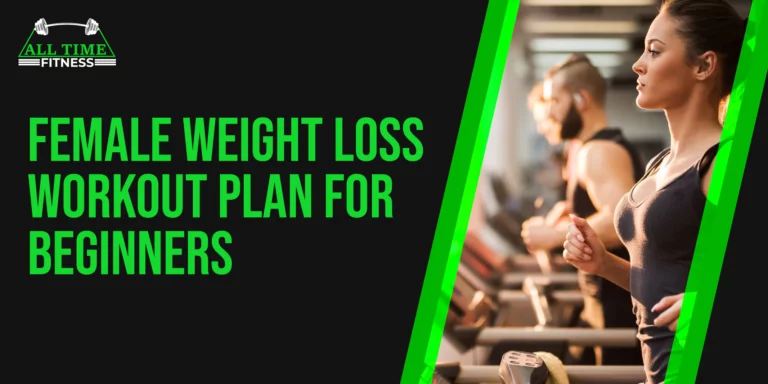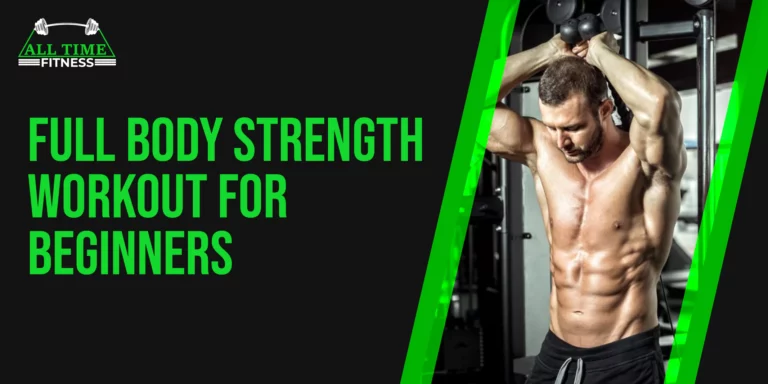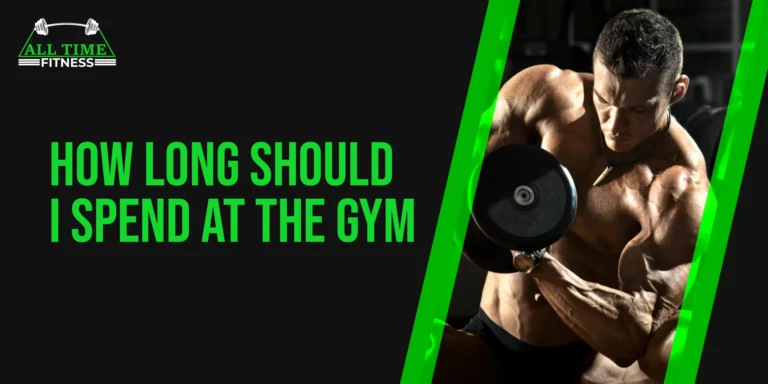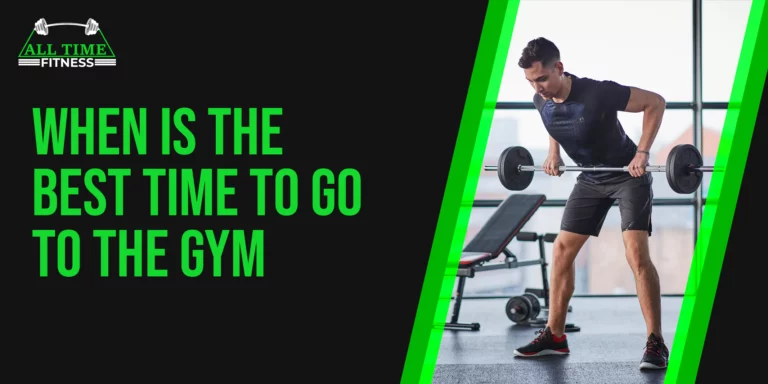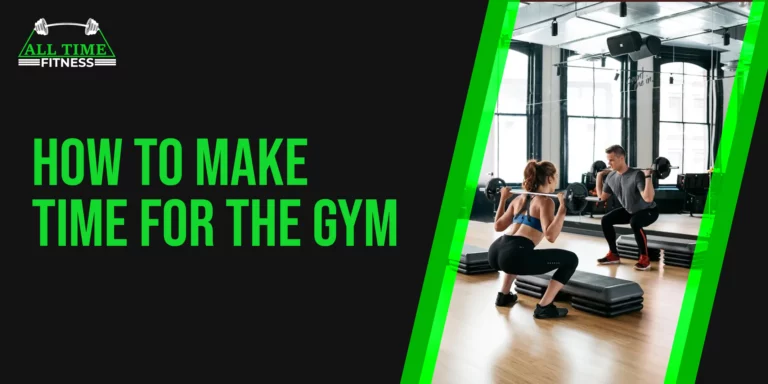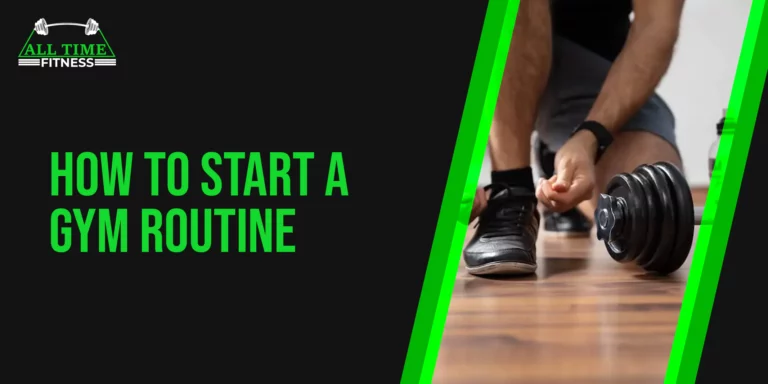Starting cardio can feel like running in circles, right? Should you go all out or take it slow? Do you keep it at 5 minutes in the first week or try longer sessions?
Cardio is great for heart health, weight loss, energy levels, and mental well-being. But to reap these benefits, you need to know the right approach to cardio workouts for beginners.
That’s what we’ll help you do today. In this article, we’ll explain the beginner gym cardio workout so you know where to begin and how to get the most out of your sessions.
Monitoring Intensity
Monitoring intensity during cardio is key. It ensures you’re working hard enough to see results without overdoing it. Knowing how to control your workout intensity helps you stay safe and get the most out of your routine.
Use the talk test: If you can talk but not sing during your workout, you’re at the right intensity. Try chatting with a friend or reciting lyrics in your head. It’s a simple way to gauge how hard you’re working.
Check your heart rate: Invest in a heart rate monitor to track your pulse. Aim for 50-70% of your maximum heart rate for moderate intensity. This tool gives you real-time feedback on your effort level.
Adjust based on perceived exertion: Rate your effort on a scale from 1 to 10. Aim for 5 to 7 during your workout. If it feels too easy, push a bit harder. If it’s too tough, ease off. Use this method to find the right balance.
Cardio Exercise Routine For Beginners
Cardio exercises for beginners should be simple and effective. Start with easy activities like walking, jogging, or cycling. These exercises are great for getting your heart rate up without being too tough. Just like strength workouts, cardio exercises are essential for overall fitness. Mix things up to keep it interesting and stay motivated.
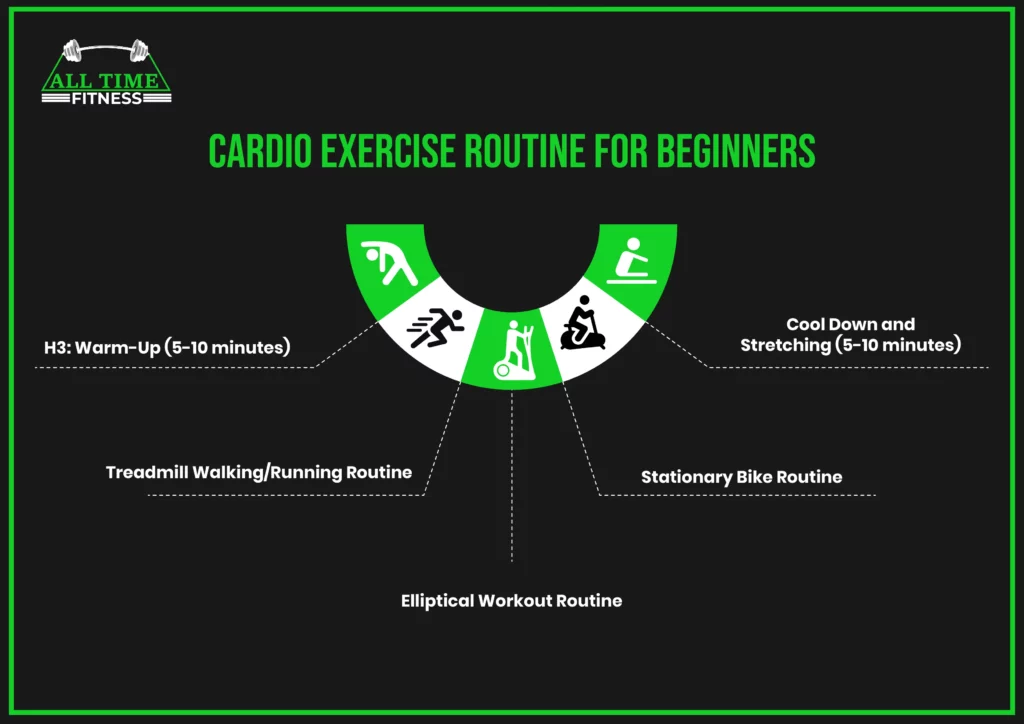
Treadmill Walking/Running Routine
Start with a comfortable pace on the treadmill for 5 minutes to get your muscles ready. Then, switch between fast walking or jogging and brisk walking for 20 minutes. Finish with a 5-minute cool down to gradually lower your heart rate.
| Phase | Time | Activity | Speed | Details |
| Warm-Up | 5 minutes | Walk | 3.2-3.5 mph | Increase speed slowly |
| Main Workout | 20 minutes | Intervals: Fast walk/jog & brisk walk | 3.6-4.0 mph (fast walk/jog), 3.0-3.5 mph (brisk walk) | Alternate 2 minutes fast walk/jog, 1 minute brisk walk |
| Cool Down | 5 minutes | Walk | Gradually slow down | Lower heart rate gradually |
Benefits:
- Prepares your muscles and reduces the risk of injury.
- Improves cardiovascular health and burns calories.
- Helps your body return to its normal state and reduces muscle soreness.
Elliptical Workout Routine
Start your elliptical workout with a gentle pace for 5 minutes. Then, alternate between moderate and high resistance for 15-20 minutes. Finish with a gentle pace for 5 minutes to cool down.
| Phase | Time | Activity | Resistance | Details |
| Warm-Up | 5 minutes | Easy pace | Low (Level 1-3) | Gradually increase resistance |
| Main Workout | 15-20 minutes | Intervals: Moderate & high resistance | Moderate (Level 5-6), High (Level 7-8) | Alternate 2 minutes moderate, 1 minute high resistance |
| Cool Down | 5 minutes | Easy pace | Low | Gradually decrease resistance |
Benefits:
- Loosens your muscles and prepares them for more intense exercise.
- Improves endurance and tones lower body muscles.
- Prevents stiffness and helps your muscles recover faster.
Stationary Bike Routine
Begin with 5 minutes of light resistance cycling to warm up your muscles. Then, cycle at a steady pace with moderate resistance for 15-20 minutes. End with 5 minutes of light resistance cycling to cool down.
| Phase | Time | Activity | Resistance | Details |
| Warm-Up | 5 minutes | Light cycling | Low | Prepare muscles for workout |
| Main Workout | 15-20 minutes | Steady cycling | Moderate | Keep a consistent pace and resistance |
| Cool Down | 5 minutes | Light cycling | Low | Gradually reduce resistance and pace |
Benefits:
- Gets your heart rate up and muscles ready.
- Improves cardiovascular fitness and strengthens leg muscles.
- Reduces muscle tension and promotes relaxation.
TLDR:
Always finish your beginner cardio exercise with a cool down and stretching. Walk at a gentle pace for 5 minutes to gradually lower your heart rate. Then spend 5 minutes doing static stretches. Focus on your legs, hips, and back to help your muscles recover.
Why Beginners Should Never Skimp On Cardio Workouts?
Cardio workouts offer a variety of benefits, including physical and mental health improvements. With a solid cardio workout routine, you’ll gain more energy and feel like a new person.
Here’s a closer look at what cardio can do for you:
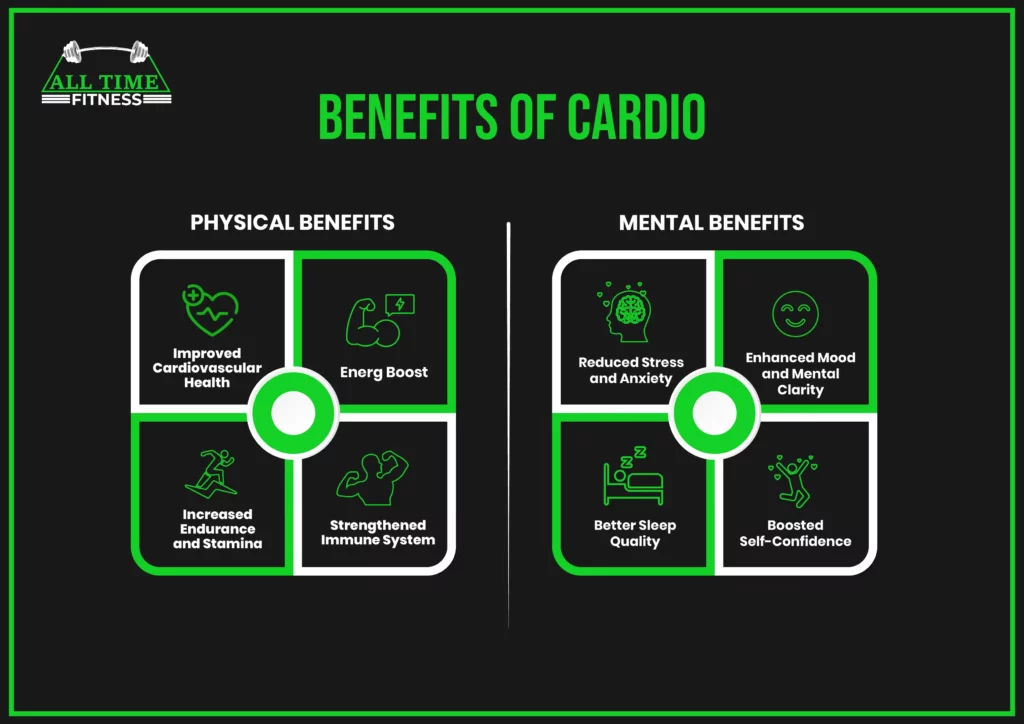
Physical Perks
Better Heart Health
It’s no secret that cardio is great for heart health. When you do cardio, you’re exercising your heart and directing oxygen-rich blood into it. Start with walking or light jogging and gradually build strength.
Boosted Energy
Cardio allows your body to use oxygen more efficiently. Even easy cardio for beginners has a positive impact on energy levels. Doing cardio regularly helps you feel more energetic and less fatigued throughout the day.
Increased Endurance and Stamina
Regular cardio builds endurance and stamina, making daily tasks easier. Beginners should start with interval training to gradually build up stamina. Over time, you’ll find activities become less tiring and more enjoyable.
Enhanced Immune System
Cardio boosts your immune system, helping you stay healthier. Engaging in a cardio routine for beginners like brisk walking or light running can strengthen your immune response. This makes it easier to fend off common illnesses and stay in good shape.
Mental Perks
Less Anxiety and Stress
Cardio helps reduce stress and anxiety by releasing endorphins. These natural mood boosters make you feel happier and more relaxed. Make it a habit to do regular cardio and see the difference it makes in your well-being.
More Self-Confidence
Regular cardio boosts self-confidence by improving your physical health and appearance. Following a consistent cardio gym workout plan for beginners helps you feel more accomplished and confident in your abilities.
Better Sleep
Cardio helps regulate your sleep patterns, making it easier to fall asleep and stay asleep. Adding light running or elliptical training to your routine can improve sleep quality. You’ll wake up feeling more rested and refreshed.
Improved Mood and Focus
Regular cardio improves your mood and mental clarity. It helps you think more clearly and stay focused. Engaging in beginner cardio workouts such as cycling or jogging can lift your spirits and sharpen your mind.
Expert Tips for Beginners
Starting a new fitness routine can be challenging, but with the right approach, it becomes much easier. Here are some practical tips to help you get started and stay motivated. Follow these to make the most of your beginner cardio workouts.
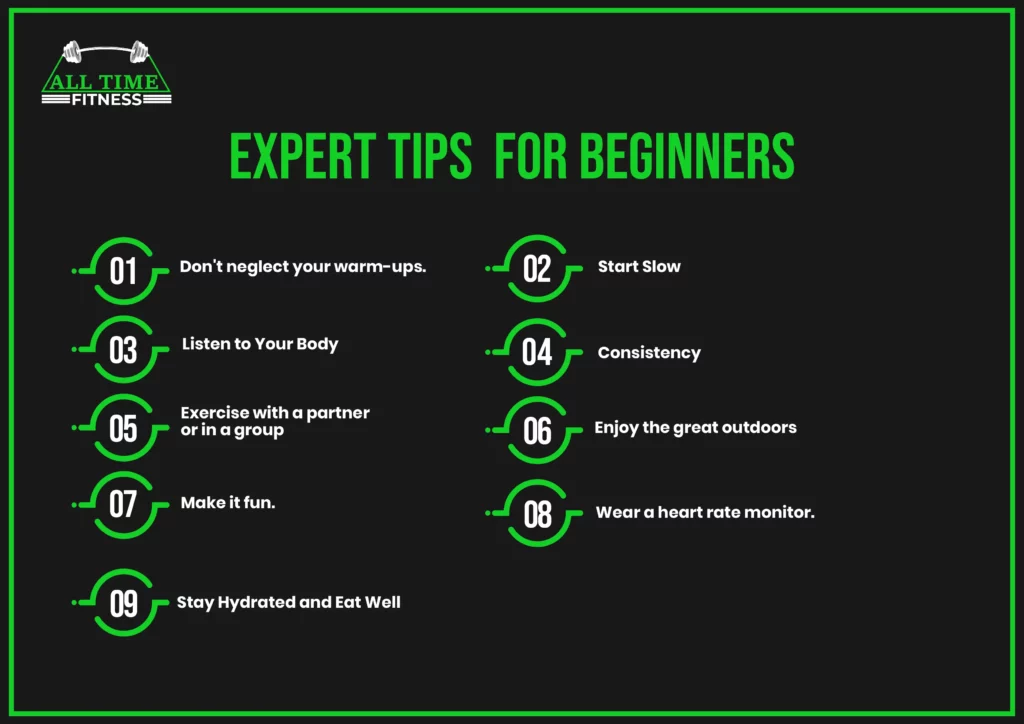
Warm Up for Success
Always warm up before starting your workout. Spend 5-10 minutes doing light activities like walking or stretching. Warming up prepares your muscles and reduces the risk of injury. It’s a crucial part of any exercise routine.
Ease Into It
Begin with shorter sessions and gradually increase the time and intensity. Pushing too hard at the start can lead to burnout or injury. Start with 10-15 minutes of cardio and slowly build up from there. Your body will thank you.
Tune Into Your Body
Pay attention to how your body feels during workouts. If something hurts or feels off, take a break. Pushing through pain can cause injuries. It’s better to take it easy and come back stronger the next day.
Stick to Your Routine
Make exercise a regular part of your routine. Aim for at least 3-4 cardio sessions a week. Consistency is key to seeing progress and building endurance. Keep a schedule and stick to it.
Find a Workout Buddy
Working out with a friend or in a group can make exercise more enjoyable. It provides motivation and accountability. Find a workout buddy or join a fitness class to stay engaged.
Take It Outside
Take your cardio outside. Fresh air and natural surroundings can make your workout more enjoyable. Go for a run in the park or hike a local trail. It’s a refreshing change from indoor routines.
Keep It Fun
Choose activities you enjoy. Whether it’s dancing, biking, or swimming, find something that makes you happy. Fun workouts are easier to stick with and help you stay motivated.
Monitor Your Heart Rate
Track your heart rate to ensure you’re working out at the right intensity. A heart rate monitor can help you stay in your target zone. It provides valuable feedback on your fitness progress.
Hydrate and Fuel Up
Drink plenty of water before, during, and after your workouts. Proper hydration is essential for performance and recovery. Also, fuel your body with nutritious foods to keep your energy levels up.
Kickstart Your Beginner Gym Cardio Journey
We’ve covered the basics of beginner cardio workouts, including different exercises and how to monitor intensity. Start with low-intensity activities like walking or cycling, and gradually increase your effort. Use the tips and machines mentioned to create a balanced routine. Now, it’s time to put on your workout gear and get moving.
FAQs
What Machines To Use At the Gym For Cardio?
For a good cardio workout, use machines like treadmills, rowing machines, upright bikes, and stair climbers. Recumbent bikes and cross trainers are also great options. If you’re into high-intensity workouts, HIIT machines and studio bikes are ideal.
What Cardio Machine Burns The Most Fat?
Running on a treadmill burns the most calories. It’s an effective way to shed fat quickly compared to other machines. The high-intensity nature of treadmill running makes it the top choice for fat burning.
What Is The Easiest Cardio To Lose Weight?
Different cardio activities burn different amounts of calories. In 30 minutes, you can burn around 185 calories by hiking, 165 calories by dancing, and 140 calories by walking at 3.5 mph. Running at 5 mph burns about 295 calories, the same as cycling at over 10 mph. Swimming can burn around 255 calories.




